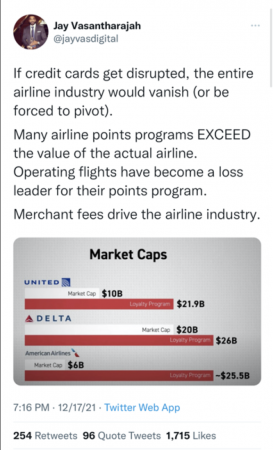Loss Leaders


Amar Pandit
A respected entrepreneur with 25+ years of Experience, Amar Pandit is the Founder of several companies that are making a Happy difference in the lives of people. He is currently the Founder of Happyness Factory, a world-class online investment & goal-based financial planning platform through which he aims to help every Indian family save and invest wisely. He is very passionate about spreading financial literacy and is the author of 4 bestselling books (+ 2 more to release in 2020), 8 Sketch Books, Board Game and 700 + columns.
January 25, 2022 | 5 Minute Read
Have you heard of a term called Loss Leaders?
It’s a pretty fascinating one.
A loss leader strategy is a pricing strategy that involves selling a product or service at a loss. However, this is simply done to attract customers so that one can sell additional products and services to those customers, thereby hoping to turn these loss-making customers into profitable ones.
Look at this tweet about a loss leader strategy in the airline industry.

If you look at the above tweet, you will realize that operating an airline means making losses. In short, operating flights is the loss leader (lose money) in the airline business model; selling loyalty (credit card reward) points is how airlines make money. Who knew that one day credit cards would be the shining knight (or beacon of hope) for airlines? If you look above, each of these airlines have loyalty programs that are worth way more than the market capitalization of these airlines. Truth be told, airlines did not have much choice given the operating realities of the business.
Airlines have used this well to their advantage without disadvantaging a customer.
A few other classic examples of loss leaders are razor blades and printer cartridges. Gillette often gives its razor for a low price, knowing that they will make money from customers buying replacement blades. The same for printer cartridges and many other products.
Investopedia cites an interesting example, “Some retailers place loss leaders at the back of their stores so consumers will have to walk by other, more expensive products to get to them. One of the most practiced examples of this is the sale of milk. Milk, a common household item, is often placed at the back of every grocery store, requiring an individual to pass by almost every other item in a grocery store.
Even if the shopper just came into the store to buy milk, it is very likely they will purchase additional items as they walk by them on their way to the milk section and then back to the register, resulting in increased sales for the shop.”
You may be wondering “What has this got to do with me?”
You may or may not be surprised but this loss leader strategy utilized by some FinTechs (rather WealthTechs) affects the strategy of all distributors and advisors.
A Venture Capitalist on a call last year said, “We are not competing with distributors.” Within 2 seconds of that statement, he slyly or foolishly said “We are only using mutual funds as loss leaders.”
Really. Using Mutual Funds as Loss Leaders.
I don’t know how many on the call understood the ramifications of this.
So, what is the issue with this strategy?
According to Investopedia –
- Loss leading is a controversial strategy that is considered predatory. Opponents of loss leader pricing strategies argue that the strategy is designed to force competitors out of business.
- Some companies use a loss leading strategy when aiming to penetrate new markets to gain market share.
- Large companies can afford to price a product with no margin because they have other products they can sell profitably to make up for the loss.
- Loss leading strategies can hurt small businesses as well as suppliers, who might be forced to keep their own prices low so that a business can continue with its loss leading strategy.”
According to Hubspot, “Many US states, Australia and Europe have banned loss leader pricing.”
While this strategy might be relevant for some industries, there is no doubt that this strategy is a predatory strategy in the context of our industry. When someone uses mutual funds as loss leaders (using a direct plan) and does not charge fees, they are only hoping to make money by selling products such as PMS, AIFs, Stock Broking and others. Firms do this because it is the easiest thing to do.
One firm had written this gem on their website which has been taken down now as the firm has become more sophisticated about the industry.
“How do we make money, you may wonder?
We don’t make money from mutual funds, but we will sell our customers PMS and AIFs. This is how we will make money. “
Do I need to elaborate more on how this hurts you (distributors and advisors)?
The point is that the nature of the competition that you are facing is very different today than it was in the past.
Some don’t understand the nuances of this business and sometimes they openly ignore regulations to acquire customers at any cost.
The only way to face this competition is to have a real value proposition for your customers and to take care of their financial lives better than anyone else.
The point that I won’t hesitate to repeat a million times fits perfectly here. “Chase excellence and deliver a world class client experience that creates a-ha moments and build life-long relationships. In short, make a real difference in the lives of people and get them to live the life they have imagined with their money.”
Similar Post
Growth
The Growth Formula of an IFA Firm
I often get asked, “What is your Growth Formula or Is there a Growth Formula that I should be following ?” We all love formulas and silver bullets and so I have attempted to ....Read More
3 January, 2020 | 7 Minute Read
Growth
The Growth Pill
I have been speaking with hundreds of distributors and advisors over the last couple of months. The trend that I see is that everyone wants to grow but very few are willing to do w ....Read More
9 June, 2020 | 5 Minute Read
Growth
Is Our Iceberg Melting?
Are you wondering what this headline question means? Let me give you a hint – it’s about changing and succeeding under any conditions. Prof. John Kotter and Holger Rathbeger ....Read More
23 August, 2022 | 5 Minute Read
Growth
The Difference between Signal and Noise that you must understand
One of my favorite blogs is Signal versus Noise (by the makers of Basecamp). They say that the blog is about “strong opinions and shared thoughts on design, business and tech”. ....Read More
25 February, 2020 | 5 Minute Read
Growth
Framework for Decision Making
Have you ever had a prospect tell you “Let Me Think (LMT)”? All of us are likely to hear these gems every now and then. As the number of people you speak to with goes up, the ....Read More
30 November, 2021 | 6 Minute Read



- 0
- 0



0 Comments